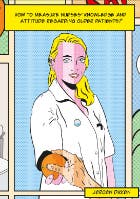Jeroen Dikken
How to measure nurses’ knowledge and attitude regarding older patients?

- Datum
- (Co) promotoren
- 20-06-2017
- prof.dr. M.J. Schuurmans, dr. J.G. Hoogerdujin
Samenvatting
Background: Worldwide, people are aging. This demographic change results in an increase of older people admitted in hospitals. A growing number of registered nurses will encounter older patients in their daily work and a good knowledge and positive attitude is often promoted.Healthcare professionals need to understand current knowledge and attitudes regarding older patients when workforce strategies for promoting positive attitudes are to be implemented. In this theses, the development and validation of two instruments is presented. Method: all studies were conducted based on the guidelines and criteria stated by the COnsensus-based Standards for the selection of health Measurement Instruments (COSMIN). Results and conclusion:The KOP-Q (Knowledge about Older Patients-Quiz) is a valid and reliable measurement tool which enables educators/researchers to measure knowledge and certainty regarding this knowledge, to give feedback on (student) nurses’ knowledge and self-reflection levels or to use as an instrument to provoke discussion between (student) nurses enabling them to learn from each other. The OPACS (Older Patient in Acute Care Survey) can be used in the USA to asses nurses practice experiences and general opinion regarding older patients and can be used for educational purposes. However, more evidence regarding validity, reliability, responsiveness and interpretability is needed. Discussion: In the Netherlands, there is still a need for a rigorous developed instrument measuring attitudes of nurses towards older patients. If we are able to measure and understand the knowledge and attitude levels of (student) nurses using measurement instruments which can make true, rightful assumptions, shortcomings of (student) nurses can be addressed in educational and quality improvement programs positively influencing the quality of care older patients receive. Given the described changes in the hospital populations combined with the societal challenges, this should be the priority concern of professionals, educators and policymakers.
